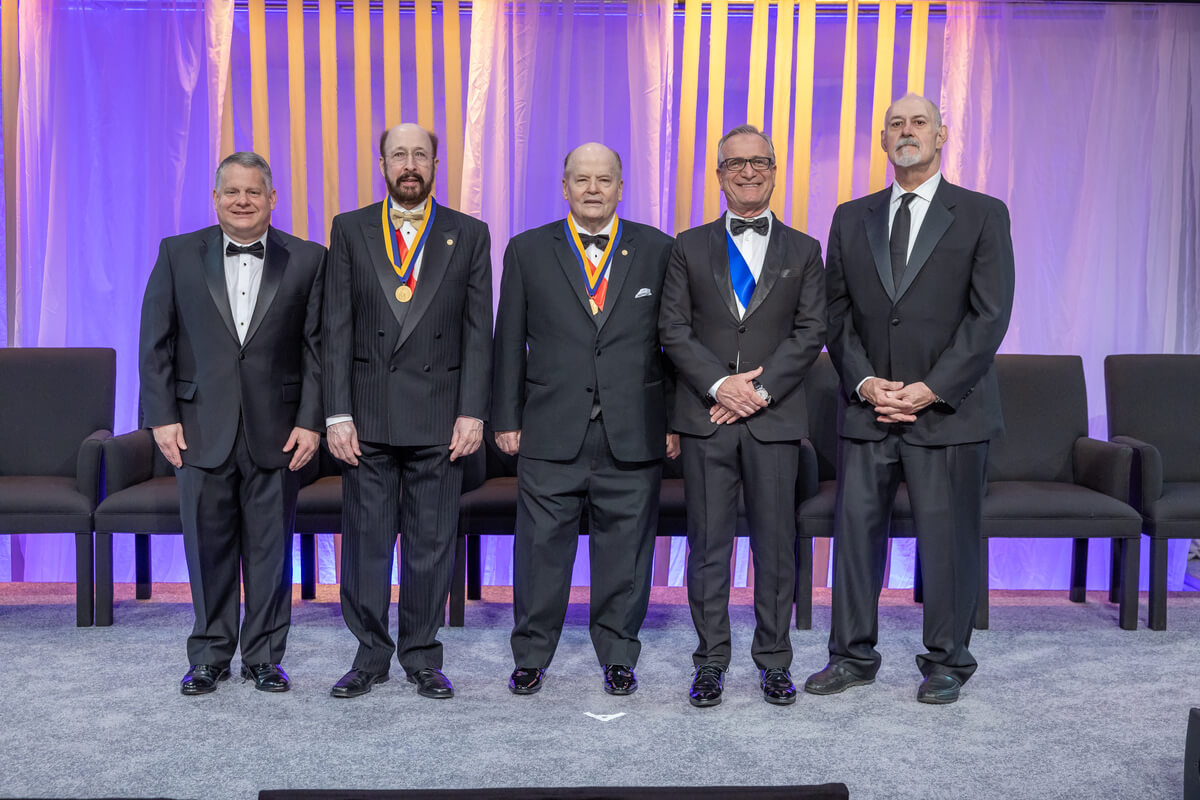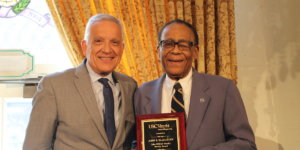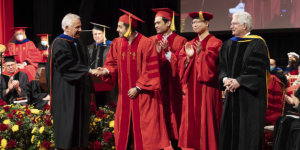
Paul Daniel Dapkus, center, received the award in Philadelphia in May 2022 (PHOTO CREDIT: The Franklin Institute)
On May 5th, Paul Daniel Dapkus, Distinguished Professor Emeritus of Electrical Engineering, Chemical Engineering and Materials Science, and Physics and Astronomy, received the Franklin Institute’s 2022 Benjamin Franklin Medal in Electrical Engineering, jointly with Russell D. Dupuis, Steve W. Chaddick Endowed Chair in Electro-Optics, of Georgia Institute of Technology,
He joins previous honorees, including Marie Curie, Thomas Edison, Albert Einstein, Stephen Hawking, Jane Goodall, and Bill Gates.
Dapkus and Dupuis were honored for their pioneering work in the development of metalorganic chemical vapor deposition (MOCVD) technology and subsequent contributions to compound semiconductor materials and devices. The process they developed directly enabled the advent of the lighting, energy, and communications technologies on which our modern world relies.
“Dan Dapkus joins a very distinguished group of USC faculty, that includes Andrew Viterbi, the school’s namesake, and the late Sol Golomb, who have received the same award in the past,” said USC Viterbi Dean Yannis Yortsos. “Through his work, Dan has fundamentally contributed to the electronics and photonics revolution in the several previous decades, that has powered technology to the unprecedented high levels it is today. We are proud to have had Dan as our faculty colleague for all the many years he served at USC, where he contributed his knowledge and ingenuity to advance science and technology for the benefit of all humanity.”
The materials Dapkus works with are, like silicon, semiconductors. However, unlike the silicon traditionally used for electronic chip manufacturing, these compound semiconductors are not naturally occurring materials. Instead, they are synthesized as thin layers on a suitable substrate. The MOCVD process enables this synthesis to occur with exquisite control and on a manufacturing scale. While Dapkus and Dupuis were not the first to create these materials by MOCVD, they quickly realized MOCVD’s potential and were the first to apply it in new and impactful ways.
“Professor Dapkus demonstrated an advantage of MOCVD to grow III-V compound-based devices …for the first time. Without his contributions, I could never invent blue LEDs and laser diodes in the 1990s using the MOCVD.”
– Professor Shuji Nakamura, 2014 Nobel Laureate in Physics
This innovative process directly enables technologies such as LEDs, solar cells, and components for fiber optics. This technology’s contribution to lighting efficiency specifically cannot be understated. LED lighting is 10 times more energy efficient than incandescent bulbs and four times more efficient than fluorescent lighting. Simply put, Dapkus’ innovations have directly contributed to a massive reduction in energy consumption across the world. In fact, a full quarter of all the energy used in the modern world goes to lighting. Similarly, virtually all of the photonic components that make up the infrastructure of our optical communications systems are manufactured by MOCVD, many using device designs that Dapkus pioneered.
Praise for Dapkus came readily from fellow researchers and colleagues. “The technology Dan and Russ pioneered lowers the energy cost of lighting and greatly reduces the consumption of fossil fuels and the rate of increase of global warming,” said Bahram Nabet, professor of electrical engineering at Drexel University and chairman of the committee that chose Dapkus and Dupuis for the honor. “It was a pleasure to work on this case and recognize the scientists whose life’s work has had such impactful contributions to human society.”
“Professor Dapkus demonstrated an advantage of MOCVD to grow III-V compound-based devices compared to molecular beam epitaxy and liquid phase epitaxy in 1977 for the first time. Since his demonstration, many people all over the world including me have joined MOCVD growth. Without his contributions, I could never invent blue LEDs and laser diodes in the 1990s using the MOCVD,” said Shuji Nakamura, 2014 Nobel laureate in physics and professor of materials and electrical and computer engineering at UC Santa Barabara.
Dapkus is the author of more than 500 publications and earned his B.S., M.S., and Ph.D. degrees in physics from the University of Illinois in 1966, 1967, and 1970. Among his 50 USC Ph.D. students are many photonics leaders in academia and industry.
This award adds to a long list of accolades for one of USC Viterbi’s most distinguished researchers. He has received several awards for innovations in photonic materials and devices, including the IEEE Jun-Ichi Nishizawa Medal, the John Tyndall Award, the IEEE David Sarnoff Award, Heinrich Welker Award of the ISCS, the Nick Holonyak, Jr. Award of OSA, the IEEE Photonics Society Engineering Achievement Award, the SPIE Technology Achievement Award and was an IEEE Photonics Society Distinguished Lecturer. Dapkus is a Member of the U.S. National Academy of Engineering and the National Academy of Inventors and a Fellow of the IEEE, APS, Optica and AAAS. He was a co-founder of E2O and T-Networks, startup companies in the optical communications industry.
“Being chosen as the 2022 Benjamin Franklin Medal Laureate in Electrical Engineering is truly humbling. In addition to the many great scientists who have been honored by the Franklin Institute over its long history, my doctoral thesis advisor, Nick Holonyak, Jr. and two USC communications pioneers, Andrew Viterbi and Sol Golomb, all were awarded this same medal,” said Dapkus. “Adding my name to such a list is both a profound personal and professional honor.”
Watch a video of Dapkus and Dupuis’ contributions below
Published on June 13th, 2022
Last updated on June 13th, 2022













